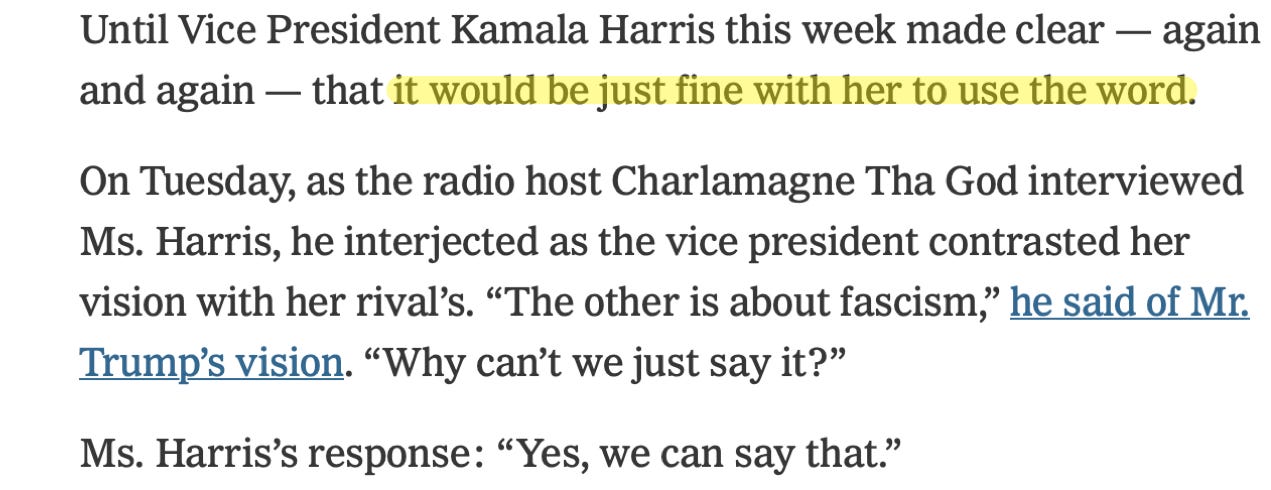
Using fear as a tool? Trump? Please. You must be kidding me. After four years of steady pandemic fearmongering, this article —ostensibly about the politics of fear— was deliriously ironic and hyper-hypocritical. Still, at least superficially, the paper held true to brand. But the article’s real purpose was much more sinister and subversive. So let’s rip off the elegant mask of journalistic trickery and reveal the gruesome demon of deception underneath.
You won’t believe how low the Times sunk this time. (Well, you’ll probably believe it, but it’s still shocking.) Here was the narrative you were meant to understand:

Pause for a moment and consider how profoundly ironic that the Times spent two full years on daily doomsday prophesying —over a moderate flu season!— just to suddenly reverse fifty years of its anti-nuclear activism and wave away the clear and present dangers as though looming nuclear disaster was more made up than covid.
I needn’t offer any evidence of this self-evident fact, but I will anyway. (Lawyer’s habit.) As recently as January —before Russia’s expanded nuclear policy and before Iran attacked Israel twice— the Bulletin of the Atomic Scientists set its iconic “Doomsday Clock” at 90 seconds to midnight. In the Atomic Scientists’ scheme, midnight is no bueno. It’s game over, finito, plug pulled. In their own words: “the deteriorating state of the world … is ... the closest to global catastrophe it has ever been.”
To take the Times’ story at face value, we must assume that mendacious reporter Michael Gold is blissfully unaware of the Doomsday Clock, and that Gold honestly thinks Trump is stitching together the threat of nuclear annihilation out of whole cloth, as a political prop, rather than Trump reiterating what some of the smartest people alive believe to be an established fact.
Reporter Gold didn’t even bother asking any experts to agree that Trump’s World War III claims were exaggerated. What do nuclear strategists and international relations scholars say about the current risks of global conflict? The Times just expected us to take their word for it.
The lack of experts quoted for the article, and the omission of context like the Bulletin of Atomic Scientists, reveals this disturbing article isn’t journalism at all. It’s a psychological operation.
The Times sought to paint the prospect of global thermonuclear war as merely a hyperbolic political cartoon. But don't be deceived; this article was not actually intended to chide Trump for fearmongering. Or at least, that wasn’t its main objective. The article was a psyop, intended to teach the Times’ liberal readers what to think about the Biden Administration’s nuclear brinksmanship. The writer wants readers to conclude that nuclear red-lining is not, in fact, an altogether new and disastrous development, but that our leaders' pugilistic dancing across Russian red lines is sound policy.
In other words, this article was not meant to associate Trump with fissile fearmongering. It was the other was around. It was meant to associate concerns about nuclear war with deplorable former President Trump. The Times knows its readers hate Trump and reflexively hate and doubt whatever Trump thinks. So if they mock Trump for his WWIII concern, most liberal Times readers will line up and clap like trained seals. Haha! World War III! Like that could ever happen! What a moron!
In other words, the Times is trying to close the Overton Window on criticism of U.S. military policy. Anyone who questions whether the Administration’s military policy is sane will be just like Trump.
Why do they do this kind of psychological manipulation? There are several reasons. It desensitizes people to real escalations in military policy. It discredits any opposition to new military escalation in advance. It makes Biden warmongering look reasonable when contrasted with Trump fearmongering. And it controls the narrative by masking legitimate concerns over Biden foreign policy decisions.
You might ask, what kind of foreign policy decisions does an article like this help to sell? How about a decision to help Ukraine launch U.S. missiles at Russian cities? Or what about a decision to escalate the Middle East conflict? There’s no telling. It’s less clear than ever who is calling the shots. From Newsweek, two days ago:

In other words, Biden told reporters that “no” more troops would be sent to the Middle East one day before the Pentagon sent thousands more US troops there. It’s like they’re not even trying that hard to pretend Biden is still running the show.

☕️ KNUCKLEHEADS ☙ Wednesday, October 2, 2024 ☙ C&C NEWS 🦠
Hurricane suggestions; debate fallout; Mideast fog of war; exposing NYT propaganda; random notions; meme of the week; more.








